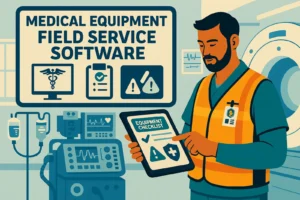Introduction
The world of business today is more challenging than ever. Companies in many sectors are under constant pressure to enhance efficiency and cut expenses without compromising on quality. One area that always comes under scrutiny is field service operations. Be it maintenance, repairs, installations, or customer care, field services can consume a significant portion of the overall budget. With fierce competition and increasing customer demands, many firms are adopting smart field service cost reduction strategies to keep operations lean and profitable. By embracing creative solutions and modern technology, organisations are not only cutting costs but also enhancing customer experiences and responsiveness. In this piece, we explore several proven techniques showing how an organization can streamline its field service operations into a dependable, cost-effective arm of the business. Along the way, we’ll also touch on ideas like fuel monitoring, parts cost analysis, and process automation to aid these efforts.
Field Service Cost Reduction Strategies Tools
Businesses today are increasingly eager to find smart ways to operate. One area witnessing major innovation involves field service cost reduction strategies. This is not just about cutting expenses – it’s about rethinking how work is organised, empowering people with better tools, and ensuring every move is efficient. By incorporating advanced scheduling, modern communication, and data analytics, companies can see a real boost in labour efficiency while reducing unexpected costs. These strategies blend technology with practical improvements, ensuring that teams work smarter, not harder.
field service cost reduction strategies
One common theme is the necessity for careful planning and the effective use of new systems. When viewed in the context of overall business improvement, field service cost reduction strategies can be a strategic plan that connects proper training with modern technology. This approach not only supports the front-line service teams but also provides real-time insights that lead to better decision-making.
Optimise Workforce Management
Intelligent Scheduling
Reducing overhead begins with the daily schedule. Using intelligent scheduling systems has become a vital part of many cost-saving plans. Rather than dispatching technicians randomly, modern software helps assign jobs based on real-time needs, location data, and even traffic updates. For example, with effective fuel monitoring incorporated into these systems, companies can design optimal routes that reduce extra mileage and save on fuel costs. These scheduling tools reduce idle time while boosting labour efficiency, ensuring every technician's time is well utilised.The technology now easily integrates with Geographic Information System data, which helps design the best routes between various client sites. When a technician sees the most efficient path — taking into account current road conditions — more jobs can be done in a day. Machine learning techniques further refine schedules by predicting busy times in different areas. This forward-thinking method reduces the need for overtime and cuts back on fuel usage, all while keeping customer appointments on schedule.
Employee Training
Nothing beats the value of a well-trained team. By investing in solid training programs, companies can enhance the overall efficiency of their field staff. Workers who know their craft well are more likely to diagnose problems correctly on the first call, which in turn saves time and money. When employees understand the new field service cost reduction strategies, they become more comfortable with using mobile devices, diagnostic tools, and even process automation systems that simplify routine tasks.Imagine a training course that covers everything from advanced diagnostics to effective customer interactions. With proper coaching, technicians can resolve issues right the first time, reducing the need for follow-up visits. Not only does this build trust with customers, but it also keeps expenses in check. Regular training updates ensure that the workforce remains aligned with the latest service procedures and technological upgrades, promoting continued labour efficiency and streamlining operations.
Performance Metrics
Keeping an eye on performance is essential. Key indicators such as first-time fix rates, job completion times, and customer satisfaction are crucial to understanding how well field service cost reduction strategies are working. With quality data from performance metrics, businesses can identify any weak spots and adjust quickly. Detailed data collection tools help monitor these metrics so that delays or repeated issues can be identified early.By tracking these indicators, minor issues can be corrected before they turn into major problems. Real-time dashboards also allow managers to see which technicians are excelling, spreading effective practices throughout the team. A focus on these metrics not only sharpens operations but also enhances labour efficiency and tightens overall cost control.
Leverage Technology
Mobile Connectivity
In field service, staying connected can be the difference between a smooth job and a delay. Equipping field teams with mobile devices provides real-time data right at their fingertips. Whether it is looking up customer histories or sorting out job details instantly, mobile connectivity makes the process quicker and more direct. This on-the-go access plays a key role in many field service cost reduction strategies by reducing wait times and cutting the need for unnecessary return trips.The use of specialised mobile apps is part of this tech-driven approach. These apps often include features for route planning, digital work orders, and immediate reporting. When technicians can quickly receive updates or ask for expert advice on the spot, overall service improves. This kind of connectivity also supports process automation, enabling a smoother relay of job details from the office to the field. It's a method that minimises administrative errors and reduces the time spent on paperwork.Moreover, linking mobile devices to a cloud-based system means data is always current and available from any location. Such integration greatly enhances teamwork and accountability while reducing costs.
Predictive Maintenance
Moving from reactive fixes to proactive care saves a lot of money. Predictive maintenance uses sensors and smart data tools to warn of problems before they become serious. Instead of waiting for a machine to break down, technology helps forecast issues based on readings like temperature or vibration. This shift is central to many field service cost reduction strategies, as catching a fault early prevents larger, costlier repairs later on.Sensors monitor equipment performance round the clock, analysing routine daily changes. For example, if small changes in vibration are noted, maintenance can be scheduled ahead of time. This way, companies avoid the steep costs of emergency repairs, while also preserving production capacity. In industries where downtime is particularly costly, the benefits of a strong predictive maintenance ROI are clear. It means technicians are only deployed when it’s most needed, and repair resources are used exactly where they are needed.
IOT Integration
Adding Internet of Things (IoT) devices is another step in modernising field services. IoT gadgets continuously send updates about equipment health and performance to a central system. This instant data flow means that any glitches or abnormal behaviour are spotted quickly, resulting in timely interventions and fewer unscheduled field calls. Additionally, IoT helps in parts cost analysis by signalling when components are nearing the end of their lifespan, thus avoiding even higher costs later.Devices like tablets and smartphones can relay live diagnostic data, which allows field managers to decide if a visit is really necessary. This enhanced oversight reduces wasted trips and improves resource allocation. IoT technology also improves safety by warning technicians about hazardous conditions, ensuring everyone returns home safely while controlling operational costs.
Enhance Customer Relations
Clear Communication
When it comes to customer service, clarity is key. Transparent communication sets realistic expectations by keeping customers informed throughout the service process. Automated text updates and emails can notify customers as soon as a technician is on the way or if delays are expected. In doing so, companies applying field service cost reduction strategies reduce confusion and avoid unnecessary repeat visits that increase costs.When customers know what to expect, frustration is minimised and service robustness improves. This open line of communication not only enhances customer satisfaction but also reduces the possibility of miscommunication leading to extra work. A proactive communication approach ensures service adjustments can be made when needed, allowing the team to work efficiently and keep costs low.
Customer Feedback
Listening to customer feedback is another crucial part. By regularly asking for opinions after every service call, companies can gain insights into what works and what may need adjustments. Data from surveys assists in making informed tweaks to service procedures. For instance, if multiple clients mention longer waiting times, then a review of scheduling practices might be necessary. This feedback loop plays an important role in refining field service cost reduction strategies, ensuring improvements are based on real-world outcomes.Constructive feedback also builds better long-term relationships. When companies actively respond to customer comments, clients feel valued and are more likely to remain loyal, reducing the need for costly customer re-engagement efforts. Furthermore, such feedback can indicate areas where process automation and other modern aids might further reduce costs and improve overall service quality.
Customised Solutions
Finally, no two customers are exactly alike. Offering tailored solutions ensures resources are used where they are needed most, avoiding wasted time and money. By assessing each client’s unique challenges, companies can adjust their service approach, ensuring every visit is targeted and efficient. This personalisation is a vital element of successful field service cost reduction strategies, as it avoids the pitfalls of a one-size-fits-all approach.For instance, a business servicing both homes and commercial sites might establish different operational plans. Residential services may require more flexible timing and personal communication, whereas commercial accounts could benefit from scheduled maintenance visits and contract-based support. Having distinct procedures aids in managing technician schedules, keeping labour efficiency high, and directly addressing concerns revealed by parts cost analysis.
Conclusion
In summary, reducing costs in field services involves a mixture of smart planning, modern tech, and a people-focused approach. By concentrating on workforce management through intelligent scheduling, ongoing employee training, and diligent tracking of performance, businesses can streamline work and save on expenses. Integrating convenient tech like mobile connectivity, predictive maintenance, and IoT further supports these field service cost reduction strategies by reducing unnecessary trips and enabling process automation.Clear communication and active customer feedback are also crucial components. Not only do these practices build stronger ties with clients, but they also help identify areas for further cost improvement. Whether it’s monitoring fuel usage, performing parts cost analysis, or ensuring labour efficiency through timely training, companies that adopt these methods are well-aligned to keep expenses in control.Investing in these field service cost reduction strategies today lays the groundwork for immediate operational benefits and long-term stability. As technology continues to shape our daily operations, firms that adapt early will see a boost in productivity and enjoy improved customer loyalty. The future belongs to those who innovate and optimise – making every touchpoint efficient and every service call count.
Daria Olieshko
A personal blog created for those who are looking for proven practices.


 English (US)
English (US)  English (GB)
English (GB)  English (CA)
English (CA)  English (AU)
English (AU)  English (NZ)
English (NZ)  English (ZA)
English (ZA)  Español (ES)
Español (ES)  Español (MX)
Español (MX)  Español (AR)
Español (AR)  Português (BR)
Português (BR)  Português (PT)
Português (PT)  Deutsch (DE)
Deutsch (DE)  Deutsch (AT)
Deutsch (AT)  Français (FR)
Français (FR)  Français (BE)
Français (BE)  Français (CA)
Français (CA)  Italiano
Italiano  日本語
日本語  中文
中文  हिन्दी
हिन्दी  עברית
עברית  العربية
العربية  한국어
한국어  Nederlands
Nederlands  Polski
Polski  Türkçe
Türkçe  Українська
Українська  Русский
Русский  Magyar
Magyar  Română
Română  Čeština
Čeština  Български
Български  Ελληνικά
Ελληνικά  Svenska
Svenska  Dansk
Dansk  Norsk
Norsk  Suomi
Suomi  Bahasa
Bahasa  Tiếng Việt
Tiếng Việt  Tagalog
Tagalog  ไทย
ไทย  Latviešu
Latviešu  Lietuvių
Lietuvių  Eesti
Eesti  Slovenčina
Slovenčina  Slovenščina
Slovenščina  Hrvatski
Hrvatski  Македонски
Македонски  Қазақ
Қазақ  Azərbaycan
Azərbaycan  বাংলা
বাংলা 

